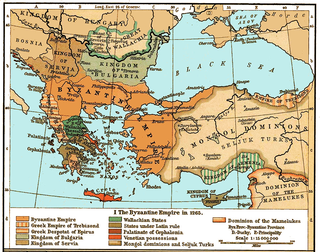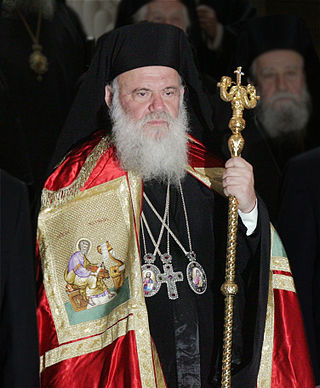Related Research Articles

The Duchy of Athens was one of the Crusader states set up in Greece after the conquest of the Byzantine Empire during the Fourth Crusade as part of the process known as Frankokratia, encompassing the regions of Attica and Boeotia, and surviving until its conquest by the Ottoman Empire in the 15th century.

The Duchy of the Archipelago, also known as Duchy of Naxos or Duchy of the Aegean, was a maritime state created by Venetian interests in the Cyclades archipelago in the Aegean Sea, in the aftermath of the Fourth Crusade, centered on the islands of Naxos and Paros. It included all the Cyclades. In 1537, it became a tributary of the Ottoman Empire, and was annexed by the Ottomans in 1579; however, Christian rule survived in islands such as Sifnos and Tinos.

The Battle of Halmyros, known by earlier scholars as the Battle of the Cephissus or Battle of Orchomenos, was fought on 15 March 1311, between the forces of the Frankish Duchy of Athens and its vassals under Walter of Brienne against the mercenaries of the Catalan Company, resulting in a decisive victory for the mercenaries.

The Duchy of Neopatras was a principality in southern Thessaly, established in 1319. Officially part of the Kingdom of Sicily, itself part of the Crown of Aragon, the duchy was governed in conjunction with the neighbouring Duchy of Athens, it enjoyed a large degree of self-government. From the mid-14th century, the duchies entered a period of decline: most of the Thessalian possessions were lost to the Serbian Empire, internal dissensions arose, along with the menace of Turkish piracy in the Aegean and the onset of Ottoman expansion in the Balkans. Enfeebled, the Catalan possessions were taken over by the Florentine adventurer Nerio I Acciaioli in 1385–1390. The title of Duke of Neopatras was held by the heir of the King of Sicily.

Othon de la Roche, also Otho de la Roche, was a Burgundian nobleman of the De la Roche family from La Roche-sur-l'Ognon. He joined the Fourth Crusade and became the first Frankish Lord of Athens in 1204. In addition to Athens, he acquired Thebes by around 1211.

Nerio I Acciaioli or Acciajuoli was the de facto Duke of Athens from 1385 to 1388, after which he reigned uncontested until his death in 1394. Born to a family of Florentine bankers, he became the principal agent of his influential kinsman, Niccolò Acciaioli, in Frankish Greece in 1360. He purchased large domains in the Principality of Achaea and administered them independently of the absent princes. He hired mercenaries and conquered Megara, a strategically important fortress in the Duchy of Athens, in 1374 or 1375. His troops again invaded the duchy in 1385. The Catalans who remained loyal to King Peter IV of Aragon could only keep the Acropolis of Athens, but they were also forced into surrender in 1388.

Antonio I Acciaioli, also known as Anthony I Acciaioli or Antonio I Acciajuoli, was Duke of Athens from 1403.
Guy or Guido Pallavicini, called Marchesopoulo by his Greek subjects, was the first marquess of Bodonitsa in Frankish Greece from 1204 to his death in or shortly after 1237. He was one of the most important Frankish rulers in Greece, and played a major role in the short-lived Kingdom of Thessalonica: in 1208–1209 he supported the Lombard rebellion against King Demetrius of Montferrat, but by 1221 he was the kingdom's regent (bailli), and was left to defend the city against the ruler of Epirus, Theodore Komnenos Doukas. Left unsupported by the Latin Empire, and with a projected crusade to relieve the city delayed, he surrendered the city in December 1224. The belated arrival of the crusade helped to save his own fief from falling to the Epirotes, however, and he was soon able to return there, dying on or shortly after 1237.

The War of the Euboeote Succession was fought in 1256–1258 between the Prince of Achaea, William of Villehardouin, and a broad coalition of other rulers from throughout Frankish Greece who felt threatened by William's aspirations. The war was sparked by Villehardouin's intervention in a succession dispute over the northern third of the island of Euboea, which was resisted by the local Lombard barons with the aid of the Republic of Venice. The Lord of Athens and Thebes, Guy I de la Roche, also entered the war against William, along with other barons of Central Greece. Their defeat at the Battle of Karydi in May/June 1258 effectively brought the war to an end in an Achaean victory, although a definite peace treaty was not concluded until 1262.
Simon Atumano was the Bishop of Gerace in Calabria from 23 June 1348 until 1366 and the Latin Archbishop of Thebes thereafter until 1380. Born in Constantinople, Atumano was of Greco-Turkish origin, his surname deriving from the word "Ottoman." He was a humanist and an influential Greek scholar during the Italian Renaissance.

The Frankokratia, also known as Latinokratia and, for the Venetian domains, Venetokratia or Enetokratia, was the period in Greek history after the Fourth Crusade (1204), when a number of primarily French and Italian states were established by the Partitio terrarum imperii Romaniae on the territory of the dissolved Byzantine Empire.

The Archdiocese of Athens is a Latin Church ecclesiastical territory or archdiocese of the Catholic Church in Greece. Its cathedra is found within the neoclassic Cathedral Basilica of St. Dionysius the Areopagite, in the episcopal see of Athens.
Kenneth Meyer Setton was an American historian and an expert on the history of medieval Europe, particularly the Crusades.
The Metropolis of Corinth, Sicyon, Zemenon, Tarsos and Polyphengos is a metropolitan see of the Church of Greece in Corinthia, Greece. Since the Middle Ages it has also existed as a Roman Catholic titular see. The current metropolitan is Dionysios Mantalos.
The Latin Archbishopric of Corinth is a titular see of the Roman Catholic Church. It dates to 1210, when a Catholic archbishop was installed on the Orthodox Metropolis of Corinth, in Southern Greece, in the aftermath of the Fourth Crusade. Since the Byzantine reconquest in the early 15th century, and except for a brief period of Venetian rule in 1688–1715, it has been awarded as a titular see. It has been vacant since 2005.

The Archbishopric of Athens is a Greek Orthodox archiepiscopal see based in the city of Athens, Greece. It is the senior see of Greece, and the seat of the autocephalous Church of Greece. Its incumbent is Ieronymos II of Athens. As the head of the Church of Greece, the holder is styled Archbishop of Athens and All Greece.
Paul was a Roman Catholic bishop from southern Italy who held various episcopal sees in the Latin East, before becoming titular Latin Patriarch of Constantinople. He was engaged in several negotiations for a possible Union of the Churches with the Byzantine Empire.
Dorotheus I was the Greek Orthodox metropolitan bishop of Athens from c. 1388 to 1392, and the first to reside in the city since 1205.
The Second Parliament of Ravennika was convened in May 1210 by Latin Emperor Henry of Flanders in the town of Ravennika in Central Greece in order to resolve the differences between the princes of Frankish Greece and the Roman Catholic clergy of their domains.
The Latin Bishopric of Salona was a Roman Catholic diocese centred on Amfissa, in Central Greece, during the period of Frankish rule there after the Fourth Crusade. The see was suppressed with the conquest of the region by the Ottoman Turks in 1410, but is retained by the Catholic Church as a titular see. It has been vacant since 1964.
References
- ↑ Ιστορικό (in Greek). Holy Metropolis of Thebes and Livadeia. 31 October 2011. Retrieved 20 November 2013.
- ↑ Vailhé, Siméon (1913). . In Herbermann, Charles (ed.). Catholic Encyclopedia . New York: Robert Appleton Company.
- ↑ Setton 1976, p. 27 (note 12).
- ↑ "Thebae". Catholic-Hierarchy.org. Retrieved 20 November 2013.
- ↑ Setton 1976, p. 149.
- ↑ Setton 1976, p. 46 (note 8).
- ↑ Setton 1976, pp. 46–47.
- ↑ Setton 1976, p. 188.
- ↑ Setton 1976, p. 308 (note 176).